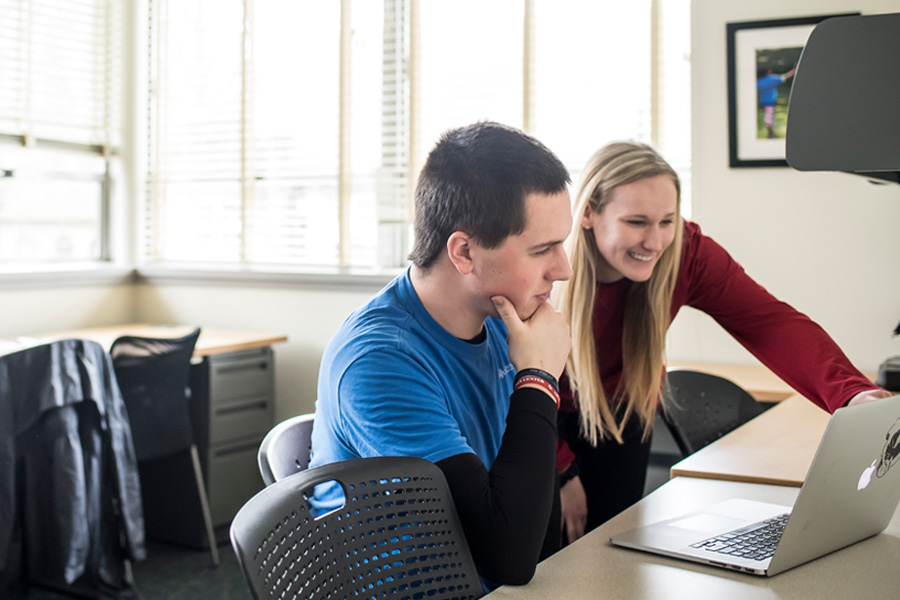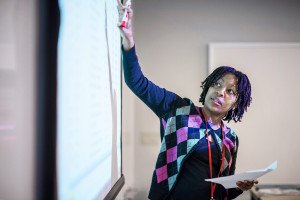Transitioning into Adult Life in Challenging Times: 5 Key Insights from an Autism Expert and the Family She’s Helped

Jessica Joseph, Ph.D., BCBA, known as “Dr. J” by her clients, is a behavioral psychologist and director of programs at Saint Joseph’s University’s Kinney Center for Autism Education and Support. While the Kinney Center has long offered programs centered on young children and adults, Dr. Joseph came to the Kinney Center to develop a unique transitional track where she helps older children and adolescents (12-20 years old) prepare to engage with the world successfully with a degree of independence.
The Kinney Center offers college preparation and career training via online and in-person classes on Saint Joseph’s open campus. During these programs, Kinney experts pair individuals on the spectrum with trained staff who guide them through skills they will need to face throughout adolescence and adulthood, from making purchases to studying to navigating their environment safely.
At a time when the region and the world is in the midst of major transition in the wake of the COVID-19 pandemic, this work is perhaps more complex and more critical than ever. We spoke with Dr. Joseph about the key concepts that help her clients thrive as they begin to engage more deeply with a challenging world.
Break Down the Activity
When Dr. Joseph started at the Kinney Center at Saint Joseph’s in 2019, she met one of the center’s first adolescent clients, Leo Vernacchio, 16. In his early teen years, Leo began working at the GET Café, a coffee shop committed to the employment of individuals of all abilities. Dr. Joseph guided Leo to help him be successful, and in doing so, was inspired to further develop the Kinney Center transition programming that now helps many other young people.
What was most beneficial to Leo as he entered the workforce was what Dr. Joseph refers to as pre-programming, the ability to talk through and practice a simple set of safety and workplace behaviors at the Kinney Center—from wearing his mask to washing his hands—before applying them in short bursts at the café.
“For pre-programming skills, we’re attending to ‘what’s a healthy behavior’ and ‘what’s not healthy?’” Dr. Joseph says. “He was able to learn how to engage safety skills in the community. That’s the great part about being on the Kinney Center’s campus. We can practice interaction with community members before he’s out in the broader world.”
According to Erica Daniels, Leo’s mother, that process was transformative.
“It helped him to focus on a specific task,” she says. “Now, he’s going in there, and he’s fully prepping food … It gives me a great sense of comfort to know that he is learning skills now that are meaningful to him that he can take with him for the rest of his life.”
Give Zoom the Benefit of the Doubt
According to Dr. Joseph, an element of control and familiarity is often important for individuals with autism when faced with a complex environment, especially during the pandemic. She worried that this would be difficult when the young people she worked with had to switch from in-person to Zoom. But, as it turns out, some actually felt more comfortable socializing virtually. During a Zoom call, new interactions can take place while the client is in familiar surroundings with more casual dress.
“A lot of times the participants who had autism were more socially engaged on the computer than their typical peers,” Dr. Joseph says. “There was less social pressure.”
Check the Little Things
Dr. Joseph points to the idea of parsimony— finding the smallest change in your physical or environmental condition that’s causing agitation—when discussing how to make a task or interaction more bearable. It could be as simple as dimming the lights, changing locations or having a snack.
“If he didn’t eat breakfast that morning, maybe just having him sit down and eating breakfast would be better at that moment and trying to say, ‘okay, it’s time to do x, it’s time to do y,’” says Joseph. “Those things are really important to understand.”
As children on the autism spectrum grow older, it’s important to help them communicate these agitations, so as they begin to go out into the world for themselves, they can help shape new environments on their own or with a companion.
Leave Room for Physical Activity
When a young person with autism is learning virtually or doing sedentary educational exercises, Dr. Joseph recommends mixing in simple physical activities to break up the time and provide an outlet for their energy. In Leo’s case, she found that even simply letting him move around while learning helped.
“Leo is an active adolescent that wants to move and shake and do different things and activities,” says Dr. Joseph. “If we’re engaging in something like money management, for instance, and he’s pacing back and forth but we’re still getting the activity done, why does he need to sit at the desk?”
Celebrate Small Wins
Dr. Joseph points to the concept of “contingency managers” as key to success, a behavioral psychology approach to positive reinforcement. She suggests trying to pick up on the good things that happen, even on off-days or off-weeks.
“A lot of times in dealing with an individual on the spectrum, people tend to focus on negative things,” says Dr. Joseph. “We’re providing him with that positive reinforcement for something that he might not really want to do, and we’re making a big deal about it. Then he’s going to want to do it with us, and he’s also going to want to do it at home with his mom.”
Erica says that taking a different, positive approach with her son, focused on navigating everyday life, has made a huge impact on their lives.
“He’s a happier, more motivated child, and he’s excited to go to school,” Erica says. “I feel a sense of relief because I know we’re on the right path now.”
This is a paid partnership between Saint Joseph's University and Philadelphia Magazine



